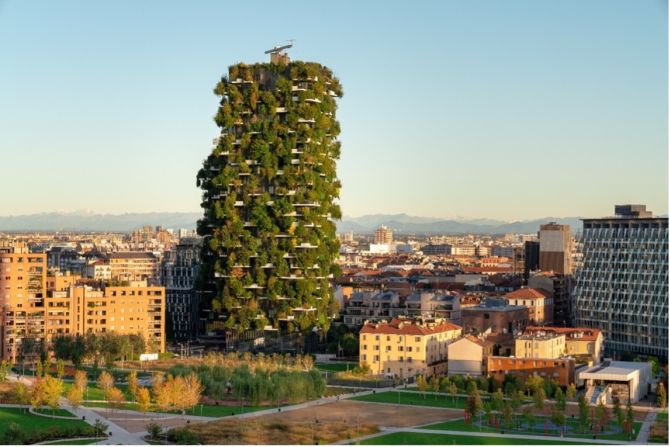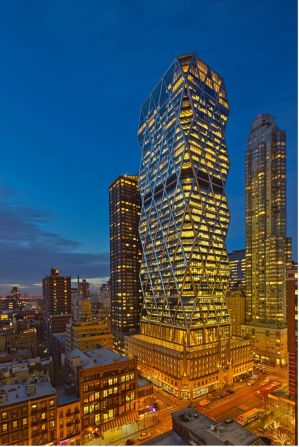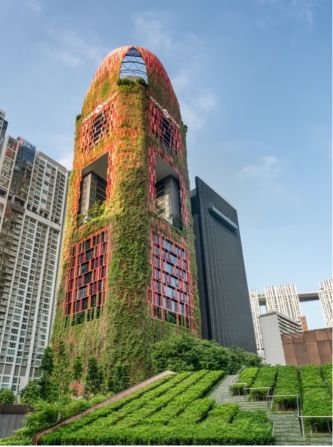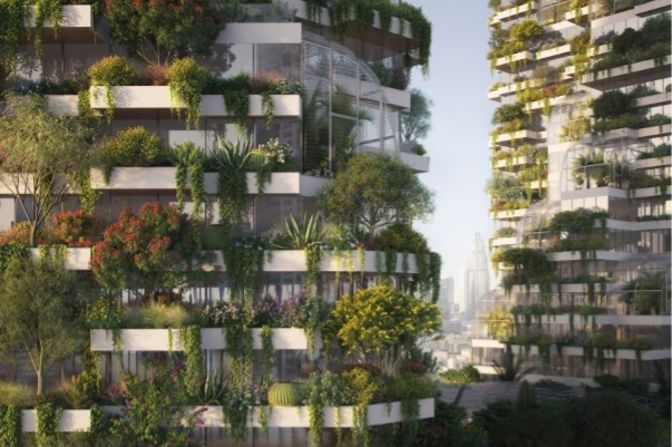Humans have long built towering structures to showcase the power of empires, rulers, religions and corporations. Today, more tall buildings are popping up than ever before. But skyscrapers could soon have a new purpose: storing renewable energy.
One of the biggest hurdles to a power grid dominated by clean energy is the intermittency of some renewable sources. Sometimes clouds roll in when solar energy is needed, or the wind stops blowing, and turbines can’t generate power. Other times, the sun and wind produce more electricity than is required.
Storage is crucial for balancing generation and consumption. A combination of technologies — from various forms of batteries to other energy storage methods — will likely be necessary to increase capacity.
Enter battery skyscrapers. At the end of May, Skidmore, Owings & Merrill (SOM), the architecture and engineering firm behind some of the world’s tallest buildings, announced a partnership with the energy storage company Energy Vault to develop new gravity energy storage solutions.
That includes a design for a skyscraper that would use a motor powered by electricity from the grid to elevate giant blocks when energy demand is low. These blocks would store the electricity as “potential” energy. When there is demand, the blocks would be lowered, releasing the energy, which would be converted into electricity.
Tall buildings are SOM’s specialty. It designed New York’s One World Trade Center, Chicago’s Willis Tower, formerly known as the Sears Tower, and the world’s tallest skyscraper, the Burj Khalifa in Dubai, which is more than 828 meters (2,700 feet) tall.
“Here’s an opportunity to take this expertise … and use it for energy storage, enabling us to wean ourselves [off] fossil fuels,” Bill Baker, a consulting partner at SOM and structural engineer for the Burj Khalifa, told CNN.
Net zero requires grid-scale storage
If the world wants to reach net zero by 2050, grid-scale storage, or technologies connected to the power grid that can store energy and deploy it when needed, will need to be ramped up, according to the International Energy Association.
Lithium-ion batteries, which are popular for electric vehicles, can’t solve the problem alone. For one, they can’t store energy for long periods.
That may be fine for shifting energy from the sunniest part of the afternoon to the evening, when demand spikes, but energy may need to be stored for longer than that.
Pumped storage hydropower, which is already widely used to store renewable energy, can do that. It entails a turbine pumping water from a reservoir on lower ground to one on higher ground during off-peak hours. When demand spikes, the water is released to flow through an electricity-generating turbine. But it requires hilly terrain and a lot of space.
SOM and Energy Vault’s superstructure tower, which could range from 300 to 1,000 meters (985 to 3,300 feet) in height, would have hollowed out structures resembling elevator shafts for moving the blocks, leaving room for residential and commercial tenants. (The firms are also looking at integrating pumped storage hydropower into skyscrapers, using water instead of blocks).
Ultimately, multi-gigawatts-hours of energy could be stored, which is enough to power several buildings, Robert Piconi, the CEO of Energy Vault, told CNN.
Two energy storage experts contacted by CNN questioned if the economics of a skyscraper battery could work, given the space that would need to be used for energy storage and the structural changes that would be needed to support the extra weight.
But Energy Vault and SOM are confident their solutions are commercially viable.
Energy Vault has already completed a project in China which it says is the world’s first commercial-scale, non-pumped hydro gravitational energy storage system. The 150-meters-tall (492 feet) building — which has a storage capacity of 100 megawatt hours — is purpose-built to store energy and doesn’t have space for tenants.
The taller the better?
Enabling the use of renewable energy would help offset the carbon footprint of supertall buildings. Today, the buildings and construction sector is responsible for almost 40% of global greenhouse gas emissions.
There is work underway to address that, from equipping buildings with better insulation to building with alternative materials that are less carbon-intensive, like timber.
Some buildings are literally getting greener. In Milan, Italian architect Stefano Boeri has created towers covered in trees and shrubs, and he has unveiled a similar design for towers in Dubai.
But buildings are getting taller and more plentiful too, at least partially to meet demand from rapid urbanization, which has driven people into cities, where limited space can mean the best way to build is up.
Between 1900 and 1999, 235 buildings taller than 200 meters (656 feet) were built globally, Daniel Safarik, of the Council on Tall Buildings and Urban Habitat, told CNN in an email. Last year, 179 buildings of that height or more were built.
When it comes to gravity-energy storage structures, the taller the better. A very tall gravity energy storage structure could offset its embodied carbon — from construction and materials — within two to four years.
“If you’re going high in a superstructure anyway, we’re just piggybacking on that,” said Piconi.”
SOM and Energy Vault are now looking for development partners to turn their designs into reality. SOM’s credibility in the tall buildings arena “will help address the challenge of getting the first one built,” said Piconi.
 almost 40% of global emissions, but designers and engineers are coming up with creative ways to make skyscrapers better for the environment. This render shows SOM and Energy Vault’s proposed superstructure tower, a skyscraper which integrates gravity energy storage. Look through the gallery to see more green building innovations.' class='image__dam-img image__dam-img--loading' onload='this.classList.remove('image__dam-img--loading')' onerror='imageLoadError(this)' height='2812' width='5000'/>
almost 40% of global emissions, but designers and engineers are coming up with creative ways to make skyscrapers better for the environment. This render shows SOM and Energy Vault’s proposed superstructure tower, a skyscraper which integrates gravity energy storage. Look through the gallery to see more green building innovations.' class='image__dam-img image__dam-img--loading' onload='this.classList.remove('image__dam-img--loading')' onerror='imageLoadError(this)' height='2812' width='5000'/> tower for trees inhabited by humans,” according to Boeri Studio, which designed the residential towers. There are two trees, eight shrubs and 40 bushes for each human being.' class='image__dam-img image__dam-img--loading' onload='this.classList.remove('image__dam-img--loading')' onerror='imageLoadError(this)' height='766' width='1148'/>
tower for trees inhabited by humans,” according to Boeri Studio, which designed the residential towers. There are two trees, eight shrubs and 40 bushes for each human being.' class='image__dam-img image__dam-img--loading' onload='this.classList.remove('image__dam-img--loading')' onerror='imageLoadError(this)' height='766' width='1148'/>
 Hearst Tower’s “diagrid” system – which creates a series of four-story triangles on the façade – eliminated the need for about 2,000 tons of steel, which is carbon-intensive to produce, according to Hearst Corporation. The roof of the New York building was designed to collect rainwater, which can be used in the air-conditioning system.' class='image__dam-img image__dam-img--loading' onload='this.classList.remove('image__dam-img--loading')' onerror='imageLoadError(this)' height='1561' width='1045' loading='lazy'/>
Hearst Tower’s “diagrid” system – which creates a series of four-story triangles on the façade – eliminated the need for about 2,000 tons of steel, which is carbon-intensive to produce, according to Hearst Corporation. The roof of the New York building was designed to collect rainwater, which can be used in the air-conditioning system.' class='image__dam-img image__dam-img--loading' onload='this.classList.remove('image__dam-img--loading')' onerror='imageLoadError(this)' height='1561' width='1045' loading='lazy'/>

 This render by Stefano Boeri Architetti shows two towers planned for Dubai that will host 2,640 trees and 27,600 shrubs on the facades, plus a system of greenhouses and hydroponic gardens.' class='image__dam-img image__dam-img--loading' onload='this.classList.remove('image__dam-img--loading')' onerror='imageLoadError(this)' height='402' width='604'/>
This render by Stefano Boeri Architetti shows two towers planned for Dubai that will host 2,640 trees and 27,600 shrubs on the facades, plus a system of greenhouses and hydroponic gardens.' class='image__dam-img image__dam-img--loading' onload='this.classList.remove('image__dam-img--loading')' onerror='imageLoadError(this)' height='402' width='604'/> 65% of the building’s original structure, such as columns, beams and slabs, and 95% of the original building’s core, according to 3XN.' class='image__dam-img image__dam-img--loading' onload='this.classList.remove('image__dam-img--loading')' onerror='imageLoadError(this)' height='4000' width='3218'/>
65% of the building’s original structure, such as columns, beams and slabs, and 95% of the original building’s core, according to 3XN.' class='image__dam-img image__dam-img--loading' onload='this.classList.remove('image__dam-img--loading')' onerror='imageLoadError(this)' height='4000' width='3218'/>